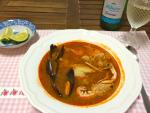
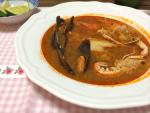
My first contact with Peruvian food was many years ago,as a teenager, in a multicultural festival held in my hometown and I have loved it since; its spiciness and perfume surprised and captivated me for ever. Years later I broaden my Peruvian food spectrum in some very good restaurants I found along my way; however, I have not cooked it at home very often. That was until last week, when we were visiting some good friends in Madrid and they invited us to a wonderful Peruvian restaurant we enjoyed so much that I later decided it was about time to try some Peruvian cuisine at home.
But first, let’s talk about this great restaurant in Madrid: is called Tampu Restaurante, not to be missed if you happen to live in or visit Madrid! The place has a great quiet atmosphere with soft lights, music and is nicely decorated. The staff is very kind, they recommended options and explained every dish they brought to the table. The menu is very varied including classic dishes from Peruvian cuisine, like ceviche or ají and also some chef creations customizing Peruvian flavours and textures and mixing them with other cuisines with a fantastic result. Here’s what we had, everything was delicious, but the duck was definitely my favourite!
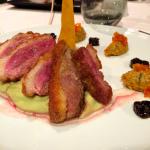
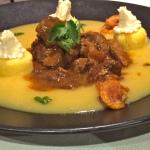
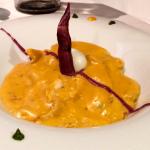
Back at home, I decided to start with a soup, of course: Parihuela, a very appreciated seafood and fish soup cooked in a fish broth perfumed with a variety of Peruvian chilli peppers (ajíes). My main concern was to get these sort of chillies, because as I read, trying to replace them with other chillies won’t work. Fortunately, the Arabic grocery store where I usually get some supplies (mainly spices) also has a Latin American section where I found everything I needed. I stocked up, as usual, with everything Peruvian I could find for this and future recipes. I bought:
- Ají Amarillo paste: made of an orange chilli pepper (Capsicum baccatum var. pendulum), quite pungent. One of the most relevant ingredients to Peruvian cuisine since Inca times, used on a daily basis as a sauce or dish ingredient. Cultivated all around the country*
- Ají Panca paste: made of a deep red chilli pepper (Capsicum chinense), very mild, also widely used in Peru in sauces and as a spice. Cultivated in the coast*
- Ají Rocoto paste: made of a yellow or red chilli pepper (Capsicum pubescens), with high pungency. Is the key ingredient in the cevivhe, the Peruvian national dish. Grown in the Andes region, is typical from Arequipa cuisine*
- Achiote paste: made of the seeds of a subtropical shrub (Bixa orellana) used as a flavor and color additive in Latin American cuisine. Also known as anatto
- Culantro paste: made of a herb native to South America. It belongs to the same botanical family (Apiaceae) as cilantro (Coriandrum sativum) but is a different species (Eryngium foetidum)
*Source: The Chile Pepper Institute Newsletter, Volume VI, Number 3, Fall 1997. http://www.nmsu.edu/-hotchile/index.htmIE-mail: [email protected]
I think you should be able to find these ingredients in any Latin Store, or sometimes big supermarkets have international food sections with Latin products as well.
And now, let’s cook!
Servings: 4
Preparation time: 20 minutes
Cooking time: 15 minutes
Ingredients
- a dash of olive oil
- 1 onion, chopped
- 1 garlic clove, pressed
- 1 teaspoonful of ají amarillo paste
- 1 teaspoonful of ají panca paste
- 1 teaspoonful of ají rocoto paste
- 1 tomato, diced
- salt and pepper to taste
- Cumin to taste
- 1/2 glass of white wine
- 1 liter fish stock
- Seafood mix, quantities and the kind of seafood don’t really matter here, add a choice of your favourite/available seafood. I bought a fresh seafood mix (you could also use frozen) ready to use for paella containing:
- 10 mussels
- 4 clams
- 12 shrimp
- 4 prawns
- 2 white fish fillets (I used frozen panga)
- Fresh parsley, chopped
- 1 teaspoonful of culantro paste
- Lime wedges to serve
Preparation
Heat the oil in a cooking pan, sauté over low-medium heat the garlic and onion until translucent. Add the ajíes (amarillo, panca and rocoto) and the tomato, season with salt, pepper, cumin and stir to combine.
Continue by pouring the wine and allow the alcohol to evaporate, then stir in the stock and bring to a boil. Drop in the mussels and the clams, cook until they open. Incorporate the shrimps, prawns and fish fillets; add the parsley and culantro paste, stir and cook on a medium heat for around 15 minutes.
Serve very hot with lime wedges and enjoy! I accompanied it with a Riveiro wine (Galicia designation of origin), a perfect match!
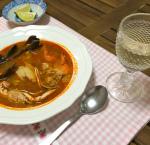
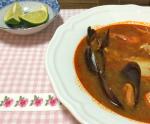
Filed under: Peruvian, Restaurant Reviews Tagged: ají, chilli pepper, clams, clean eating, healthy food, low calorie, low carb, low fat, mussels, prawns, seafood, shrimps, spicy food, white fish, whole food



